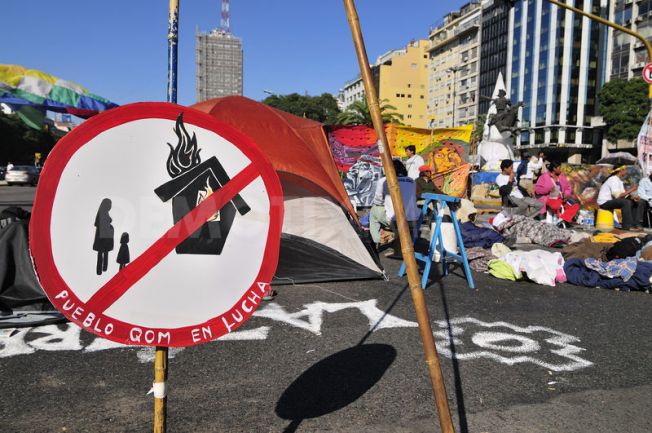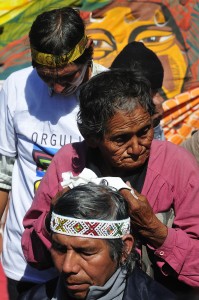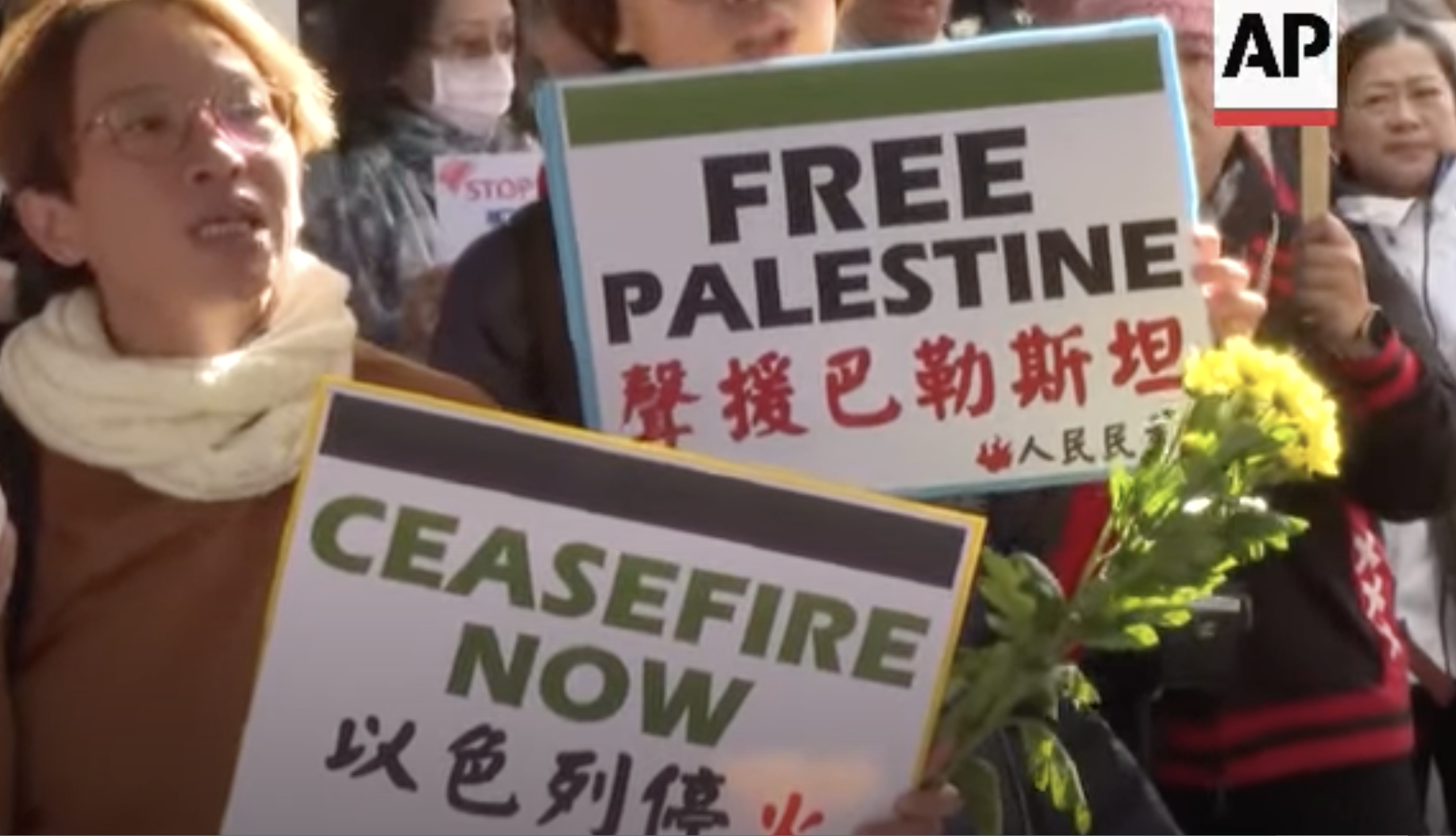Since Monday April 25, activists from the Qom community, an indigenous group from the province of Formosa, started a roadblock on the 9 de Julio Avenue in the very center of Buenos Aires.
Some members of the group, led by Felix Díaz, also started a hunger strike, arguing that they have been left with no other choice, as reported by Tiempo Argentino [es].
The protests aim to draw public attention to the alleged police abuses committed during the dismantlement of the roadblock of Route 86 by the Qom Community last November. The dismantlement ended up with the death of one police officer and one indigenous man, Roberto López. The clarification of the case is another of Qom’s claims.

During protests in Buenos Aires the Qom put up a sign of a house burning, referring to police repression in Formosa during November 2010. Image by Patricio Murphy, Copyright Demotix
Mariana Espinosa, in the blog Red Latina Sin Fronteras [es], expressed her concern over the repression the indigenous people suffered in Formosa:
Los pueblos originarios, existen y necesitan de todos nosotros, no queremos un muerto más, un dolor más, una tristeza más, un enferma mas, queremos justicia para Roberto Lopez…
In their blog [es], Qom community members proclaim their determination to go on with the protest whatever happens:
Muy errados están los que piensan que golpeándonos, matándonos, deteniéndonos, quemando nuestras casas e inventándonos causas penales nos detendrán.
The conflict has its origins in a land dispute. The Qoms denounce the usurpation of 1300 hectares of land by the government of Gildo Insfrán, governor of the province of Formosa, a province that is home to 180 indigenous communities.
In the blog Un alumno Diferente [es], Jésus David gives a quick summary of the land dispute:
El conflicto por la posesión de tierras se inició a mediados de 2010, cuando el gobernador formoseño Gildo Insfrán cedió a la Universidad Nacional de Formosa los terrenos en los que vive la comunidad Qom, que posee los títulos de propiedad otorgados por el Gobierno nacional en 1940. Tras ser desalojados, los habitantes cortaron durante poco más de tres meses el tránsito en la ruta nacional 86.
Daniel Gaguine, in his blog El Caleidoscopio de Lucy [es], explains why the land theme is so important for the indigenous people:
Muchas de las tierras fueron adquiridas por empresas y particulares de fuerte poderío económico, causando graves dificultades en lo que sería uno de los “pulmones” del norte del país, con lo que sería la poda de árboles y demás.
He also interviewed Pablo Gramajo, one of the demonstrators of 9 de Julio in Buenos Aires, who highlights the clash between the official and indigenous point of view :
El problema de la expulsión de la tierra no es solo en Formosa sino de todo el norte argentine… Lo que ustedes llaman “desarrollo”, nosotros le decimos “forma de vida” y el desarrollo no va con nuestra forma de vida.

"Members of the QOM indigenous community seen here as they block a road demanding the restitution of their lands." Image by Patricio Murphy, Copyright Demoti
On December 30 of last year, provincial government officials and the Qom reached a basic agreement on healthcare and security, opening the way to a peaceful resolution to the conflict. But the Qom say that the government failed to fulfill its promises, forcing them to intensify their protests again.
The blog Lalacnaqom [es] explains how Qom activists began the hunger strike and roadblock again:
Los manifestantes, pertenecientes en su totalidad a las comunidades Qom, iniciaron esta medida de fuerza con el propósito de acceder a un diálogo con los representantes del gobierno, a fin de hacer un seguimiento de las promesas firmadas en noviembre pasado. Dichas promesas … consisten en la construcción de viviendas para la comunidad Qom.
In their blog [es], Qom community activists also lament that the federal government pays so little attention to them:
Cuándo se va a reconocer la situación crítica en que nos ponen? Negar la realidad es la peor alternativa.
In his blog Señales [es], Claudio Andrés de Luca criticizes the way official media discredits the indigenous movement by not reporting their demands:
Los medios oficiales CN23, la Televisión Pública, TelAm y El Argentino decidieron darle aire al reclamo que llevan, desde hace más de 5 meses, hermanos de la comunidad Qom en Buenos Aires. Y lo hacen de la peor manera llaman a Formosa para que el ministro de Gobierno pida desde allá el levantamiento de la protesta y dialoguen, algo a lo que el Gobernador Gildo Insfrán siempre se negó. En ninguna de sus crónicas dan voz a los pedidos del los acampantes.
Many associations are supporting the Qom's struggle, including the Madres de la Plaza de Mayo, Amnesty International and the NGO of the Nobel Peace Price Adolfo Pérez Esquivel. On April 26, the Inter-American Commission on Human Rights (IACHR) expressed its concerns about the Qom's situation in Argentina. The Center for Legal and Social Studies (CELS), which brought the case to the IACHR, reacts to the case on its website:
La Comisión Interamericana de Derechos Humanos (CIDH) solicit al Estado argentino que “adoptar las medidas necesarias para garantizar la vida y la integridad física” de la comunidad qom (toba) “La Primavera”… el Estado argentine debe proteger a los indigenous “contra posibles amenazas, agresiones u hostigamientos por miembros de la policía, de la fuerza pública u otros agentes estatales”.
The Inter-American Commission of Human Rights asks the Argentine state to “adopt the measures required to safeguard the life and physical integrity of the qom (toba) community “La Primavera”… the Argentine state should protect indigenous people against every possible threats, aggressions or hostilities from members of the police, public force of other official agents.







1 comment